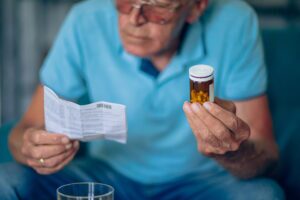Medical Review by Jennie Stanford, MD, FAAFP, DipABOM
Summary:
- Cialis® (tadalafil) and Viagra® (sildenafil) both block PDE5—but have different chemical compositions, durations, and side effects.
- Cialis® usually comes in dosages of 5 mg, 10 mg, or 20 mg. Viagra® typically comes in dosages of 25 mg, 50 mg, or 100 mg.
- Taking 20mg of Cialis® will produce a different reaction than taking 100mg of Viagra®. Cialis® can take up to 2 hours to work, and lasts up to 36 hours. Viagra® usually works within 30 minutes to 1 hour, and it lasts 4 to 6 hours.
- The side effects of Cialis® and Viagra® also differ, although they have several in common (including headaches and indigestion). Both medications can also lower blood pressure and should not be taken with nitrates.
- The amount of Cialis® or Viagra® you take should be based on your individual health needs and determined by healthcare professionals.
How do Cialis® and Viagra® compare?
The fact that Cialis® and Viagra® are both popular treatments for erectile dysfunction (ED) has led to some confusion about the two—specifically, the idea that they’re the same category but let’s discuss the differences. That’s a bit like saying beer is essentially the same as wine because they’re both alcoholic beverages.
While both Cialis® and Viagra® can make it easier to get erections by blocking the enzyme PDE5, there are differences between them that go well beyond their respective potencies. Learn more about each of these medications in detail so you can make informed decisions about taking either one.
Understanding Cialis® (Tadalafil) dosages:
Cialis®, known by its generic name tadalafil, is a popular medication for treating erectile dysfunction (ED). The dosages Cialis® comes in are tailored to provide flexibility and long-lasting effects—which is why it’s sometimes called “the weekend pill”.
Typical dosages:
- Cialis® is typically available in dosages of 5 mg, 10 mg, and 20 mg.
- A low dose (2.5 mg to 5 mg) can be used daily, while higher doses (10 mg and 20 mg) are typically taken as needed before sexual activity
.
Understanding Viagra® (Sildenafil) dosages:
Viagra®, or sildenafil, is another widely used medication for ED. Its effectiveness is well-documented, but it’s designed to last for shorter periods of time. Viagra® is often known as “the little blue pill”, due to the color of the tablets.
Typical dosages:
- Viagra® is available in dosages of 25 mg, 50 mg, and 100 mg.
- The 50 mg dose is commonly prescribed initially, but this can be adjusted by your doctor based on how well it works and your tolerance for it.
Learn more about Viagra® here.
What to expect after taking 20mg of Cialis® vs. 100mg of Viagra®
Here’s a comparison chart showing how your experience could differ depending on which option you take:
| 20mg of Cialis® (Tadalafil) | 100mg of Viagra® (Sildenafil) | |
| When to take it: | 30 minutes to 6 hours (median time of 2 hours) | 30 minutes to 4 hours (median time of 1 hour |
| Time Required for Maximum Potency: | Median time 2 hours | Median time 1 hour. |
| Length of Time Before It Wears Off: | Up to 36 hours | Usually 4 to 6 hours |
| Common Side Effects: | HeadachesIndigestionBack painMuscle aches | HeadachesFlushingIndigestionVisual disturbances |
| Potentially Severe Side Effects: | Priapism (prolonged erection)Vision changesHearing loss | Priapism (prolonged erection)Vision disturbancesHeart complications |
| Potential Risk Factors: | Not suitable for people taking nitrates or those with certain heart conditions | Not suitable for people taking nitrates or those with certain heart conditions |
*Cases where men taking Viagra® have experienced heart attacks, strokes, irregular heartbeats, or death are extremely rare—and mostly occur in men who already have heart problems before taking Viagra®. For more information, read the patient information for Viagra® here.
**Both Viagra® and Cialis® can potentially lower blood pressure and should not be taken with nitrate medications.
Key takeaways
Viagra® & Cialis® aren’t the same drug
Although both Viagra® and Cialis® block PDE5, they aren’t chemically identical. This means you may find one medication more effective than the other.
The dosage you take doesn’t determine how long the effects last
It’s a common misconception that taking more medication means it lasts longer.]The type of medication you take plays a much larger role,determining the appropriate dosage is more about finding an amount of medication that will have the desired effect on your body with the lowest acceptable level of risk.
Cialis® lasts longer than Viagra®
Taking 20mg of Cialis® can help you get an erection for the next 36 hours—whereas taking 100mg of Viagra® may wear off in 4-6 hours.
The side effects aren’t the same
While Viagra® and Cialis® have some potential side effects in common (including mild ones like headaches and more severe ones like priapism), there are different risks and risk factors associated with both drugs. This is why it’s critical to consult a healthcare professional before taking either one, and only take the dosage prescribed to you.
See also: Is it safe to take Viagra® & Cialis® at the same time?
How doctors determine your dosage
Selecting the right dosage of ED medication should always be done by a qualified medical professional, who will work with you to make a determination based on your individual health needs. Here’s some, but not all, of what a healthcare provider may consider:
- Any preexisting health conditions (especially heart disease and liver or kidney problems)
- Your age
- Whether you’re currently using other medications
- Lifestyle factors (including whether you drink alcohol and how much)
See also: Viagra® and alcohol: is it safe to use them together?
Why it may be safer to start with a lower dosage
For most people, your healthcare provider may start with a lower dose and adjust based on each individual’s response and tolerance. This approach minimizes the risk of side effects and identifies the most effective dose with the least discomfort.
Remember that appropriate dosages change over time as well—so regular follow-ups with a healthcare provider are essential if you’re taking Viagra® or Cialis®. This allows your medical provider to ensure the ongoing efficacy of the treatment and note any potential side effects early.
Get ED help from Lemonaid Health including Viagra® and Cialis®
Whether you’re interested in taking Viagra® or Cialis® for help with erectile dysfunction, the medical team at Lemonaid Health may be able to help. Lemonaid Health provides access to US-based medical practitioners who may provide prescriptions for erectile dysfunction treatment and offer personalized guidance to you about how to use them, if medically appropriate. Learn about ED treatment options today!
Viagra® is a registered trademark of Pfizer Inc. Cialis® is a registered trademark of Lilly ICOS LLC.












